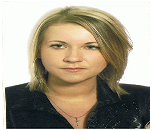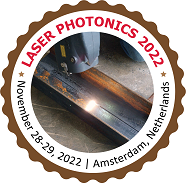Sessions and Tracks
Track 1: Laser Systems
Light amplification by stimulated discharge of radiation, or LASER. Light is an electromagnetic wave, as all of us know. Each wave has its own brightness, colour, and polarisation, or the angle at which it trembles. Although laser light is more parallel than any other kind of light, this idea nevertheless holds true for it. Since every component of the beam follows a nearly identical path, there will be very little beam divergence. A dot with a radius of around 60 mm can illuminate an object at a distance of 1 kilometre with a competent laser. Due to its parallel nature, the beam can be concentrated to very small diameters where the awareness of light vitality is so strong that you can drill, cut, or spin with it. Lasers may also be used to illuminate and see extremely small details, which is why they are also utilised in CD players and surgical procedures. It can also be very monochromatic, meaning that there is just one light wavelength present. This sample does not use common light sources. All colours in the spectrum are contained in white light, but even coloured light, such a red LED, contains a common range of red wavelengths.
Track 02: Optical Imaging and Sensing
Optical imaging, which essentially employs a certain sort of light with photonic qualities to obtain images of the internal organs and tissues along with their molecular and cellular structure, is a technique for taking non-invasive pictures of the inside of the body without utilising ionising radiation. The main uses for these photos are in medicine, where doctors would use them to diagnose patients, and in science, where they would be used in research projects.
· 3D Printed Optics and Additive Photonic Manufacturing
· Digital Optics for Immersive Displays
· Unconventional Optical Imaging
· Optical Micro- and Nano metrology
· Optics, Photonics and Digital Technologies for Imaging Applications
· Optical Sensing and Detection
· Imaging in Biology and Medicine
Track 03: Optics in Astronomy and Astrophysics
In order to obtain images of astronomical objects in space, this optics, which are a subset of optics and photonics, require light-controlling devices. The telescope would be the ideal illustration for this. Astronomical optics combines precisely machined lenses and mirrors to minimise picture distortion with sensitive sensors to find faint light sources.
· IR applications
· Aperture Synthesis
· Interferometry
· Adaptive Optics for Astronomy and Applications
Track 04: Laser absorption Spectroscopy
The study of electromagnetic spectrum interactions with matter is known as spectroscopy. The visible spectrum of light was used in spectroscopy, but it is also useful to use gamma, x-ray, and UV spectroscopy techniques. It involves all types of light-matter interactions, such as absorption, emission, scattering, etc.
Astronomers can use spectroscopy to determine an object's composition, temperature, density, and motion. The atoms and molecules in the object can be identified with the use of infrared spectroscopy. The red or blue shift in a spectral line indicates how quickly an object is moving away from or toward Earth.
Track 05: Trending technologies in Photonics and Lasers
Photonics begins with the invention of the laser. It is the study of the physical science of light detection, and generation. The fundamental element of this technology is photons. Photonics applications use photons in the same way electronic devices use electrons. As we know that light travels 10 times faster than electricity then the devices which are running on light have more advantages than the devices which are running on electricity.
Track 06: Application of Lasers and photonics in Industries
There are numerous industrial uses for lasers and photonics, including cutting, manufacturing procedures, and equipment for processing materials through welding. Industries including mechanical engineering, tool manufacture, science, and numerous other medical professions and research are just a few that are utilizing lasers and photonics more and more. Nevertheless, this development is a step forward because innovation fosters both growth and development.
Track 07: Virtual world of Photonics
Head-up displays bring project information and warnings directly into the driver's field of vision. Expanded reality (AR) projections on the windshield have recently been developed and controlled using confusing optics. Weakness: The frames take up too much room in the officially crowded dashboard and only allow a small amount of glare. The manufacturer of automotive components Continental is going a different route that is also dependent on photonics, along with its affiliated company, the US start up DigiLens Inc. Instead of using optics to manipulate the light, extremely well-organized optical waveguides are used. The inventive structure duplicates the field of vision and reduces the establishment space to a sixth of its current size. Even pilot and motorcycle headgear can be equipped with the shrunk-down HUDs to make AR data clearly visible in the field of vision.
DigiLens uses a holographic photopolymer that the company developed to build fine diffractive structures in place of focal points and mirrors. These waveguides for red, green, and blue light are coupled to these Bragg gratings using a practical ink fly printing technique. The catch: The polymer, or more precisely the degree of its diffraction, is switchable electrically. Switchable Bragg gratings (SBGs) function as an optical "framework on a chip" by diffracting, shaping, enlarging, and finally activating the light stored in optical wave-controls on the target surface. It is supported by an information module made up of an RGB LED module and a Pico projector.
Track 08: Micro photonics
Technology's field of micro photonics focuses on controlling light at the tiny level. In optical networking, it is employed. To reduce the light to a small size, micro photonics requires at least two distinct materials with significant differential refraction records. Fresnel reflection is typically used in micro photonics to regulate light for all goals and purposes. If the photons are primarily found in upper list material, then aggregate inward reflection is the reason of the repression. The device is referred to as a photonic precious stone on the off chance that the suppression is anticipated to produce several circulated Fresnel reflections. Micro photonics uses a broad variety of geometries, such as optical waveguides, optical micro cavities, and arrayed waveguide gratings.
Photonic precious stones are non-directing substances that excel in reflecting various light wavelengths. One might refer to such a gem as the perfect mirror. Micro mirrors and photonic wire waveguides are two further micro photonics devices. These tools are used to "shape the stream of light," as the term "micro photonics" is commonly used to describe its goal.
Track 09: Bio photonics
The term "bio photonics" denotes a synthesis of science and photonics, with photonics denoting the study, invention, and control of photons, quantum units of light, and their age, control, and position. Hardware and photons are the two main components of photonics. In data advancements like fibre optics, photons play the same fundamental role that electrons do in hardware.
The progress and use of optical techniques, particularly imaging, to the study of organic atoms, cells, and tissue is another way to define bio photonics. One of the main benefits of using bio photonic optical techniques is that they preserve the validity of the natural cells under examination.
As a result, all techniques that deal with the interaction between photons and natural objects have come to be referred to as "bio photonics," a phrase that has become widely used. This makes reference to the release, recognition, retention, reflection, alteration, and creation of radiation from bio molecular, cell, and tissue structures, as well as living things and biomaterials. Natural science, agriculture, pharmaceuticals, and biological sciences are areas of usage. One can distinguish between applications like therapy and medical process, which primarily use light to exchange vitality, and applications like diagnostics, which use light to energise matter and exchange data back to the administrator, similar to how "electric" and "gadgets" are separated. Often, when the word "bio photonics" is used, it refers to the last application.
Track 10: Nano Photonics
The study of how light behaves at the Nano scale and how nanometre-scale objects interact with light is known as Nano photonics or Nano-optics. It belongs to the fields of optics, optical engineering, electrical construction, and nanotechnology. It frequently (though not always) contains metallic segments that can focus and convey light using surface Plasmon polarisation.
The term "Nano-optics," like the term "optics," typically refers to situations involving strong, visible, and near-infrared light (free-space wavelengths from 300 to 1200 nanometres).
Track 11: Fibre Optic Lasers
Fibre optic lasers can be classified as fibre arc lasers, single-crystal fibre lasers, rare earth doped fibre lasers, optical fibre nonlinear effect lasers, etc. The most developed of these are rare-earth-doped fibre lasers, which may enhance light by being doped with small amounts of rare-earth halides. In optical fibre communication systems, it was frequently utilised. High fibre lasers are mostly utilised in the sectors of medicine, laser processing, and the military.
The study of light's behaviour and characteristics, including how it interacts with matter and how devices use or detect it, is the subject of the branch of physics known as optics. Visible, ultraviolet, and infrared light behaviour is often described by the science of optics. Since light is an electromagnetic wave, it shares characteristics with X-rays, microwaves, and radio waves, among other types of electromagnetic radiation.
Track 12: 3D Laser Triangulation
The use of 3D laser technology enables sensors to scan their surroundings. The center of the detector serves as the final operating point for laser triangulation systems' reflected spots. A system that uses 3D laser triangulation has a short-range but excellent accuracy, and it is comparatively unaffected by changes in surface texture or lighting. This technology has numerous uses in a wide range of industries, including scanning and inspection, medical, and criminal investigation.
Track 13: Laser communications
One of the driving forces behind the advancement of laser diode technology is optical communication. Similar to fibre optic systems, these wireless connections across the air use laser diodes to produce the signal carriers that are used as transmission mediums. As a transmission medium, light is used in optical communication.
Free space communications and sensing using lasers are helping to improve detection methods. For satellite communication, laser is used, which has the ability to transfer a lot more data than radio.
Track 14: Laser controlled areas
The term "laser" stands for light that stimulates radiation emission. When electrons in crystals or gases take in energy and become excited, a laser is produced. Areas where laser activity takes place are called "laser controlled," and as a result, safety standards and laws are followed. Lasers used in laser-controlled environments vary in power and light wavelength.
Track 15: Laser detectors
Device that functions by interacting with semiconductor-based material under incident radiation to generate an electrical signal or by interacting with calorimetric devices to generate a thermally induced current, the wavelength, intensity, and energy of the source will affect how the detection equipment reacts.
Track 16: Laser Photochemistry
The study looked at how a molecule's ability to absorb photons causes it to stimulate chemical activity when exposed to laser light. Interaction between a laser source and an atomic or molecular species a photochemical output that contains experimental data comes from research on excited state transitions.












